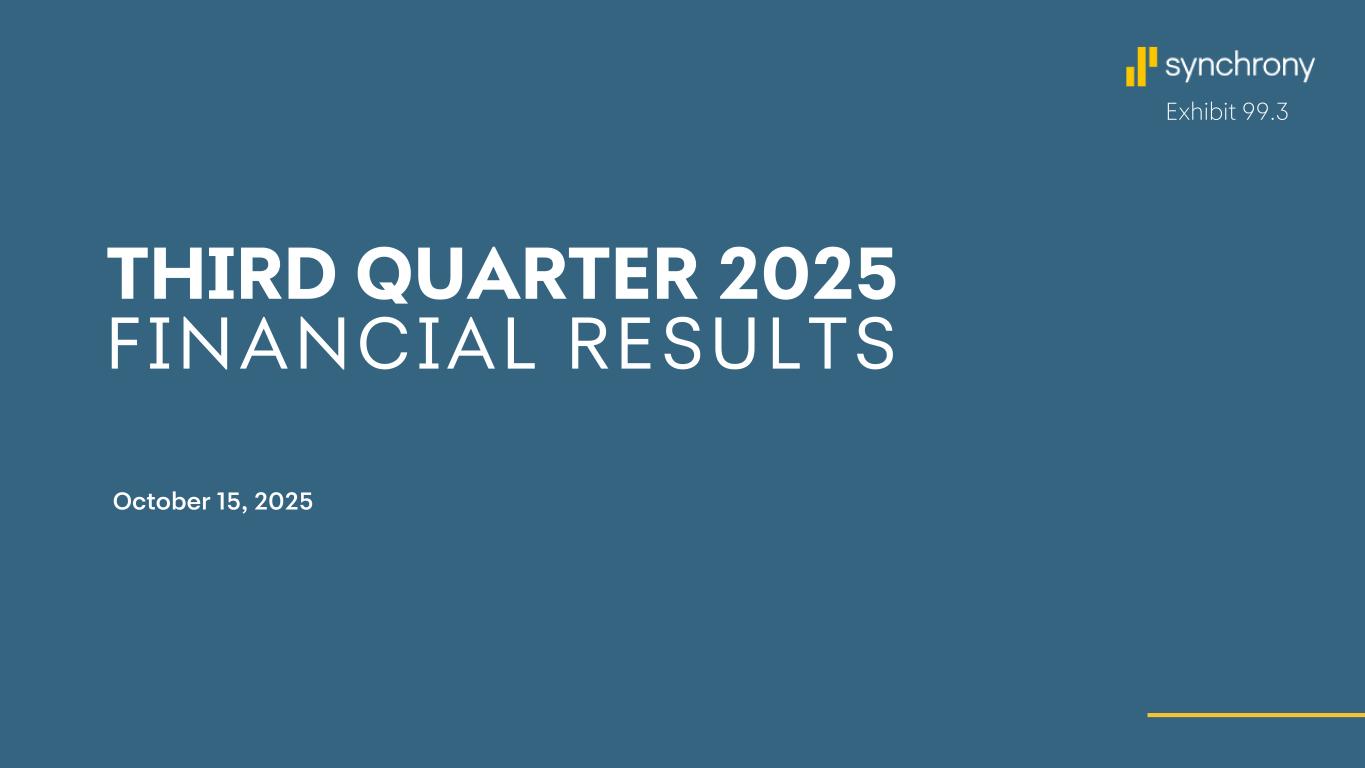
October 15, 2025 THIRD QUARTER 2025 FINANCIAL RESULTS Exhibit 99.3
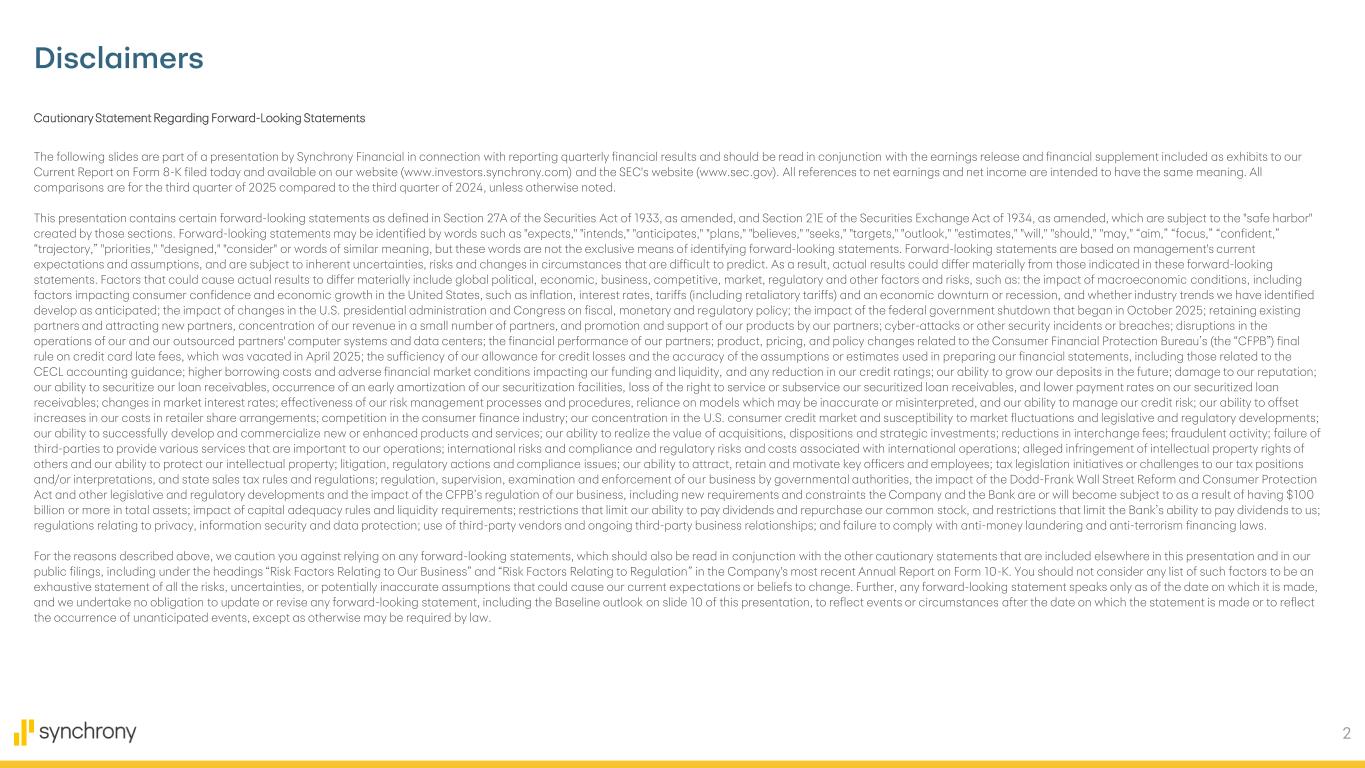
2 Cautionary Statement Regarding Forward-Looking Statements The following slides are part of a presentation by Synchrony Financial in connection with reporting quarterly financial results and should be read in conjunction with the earnings release and financial supplement included as exhibits to our Current Report on Form 8-K filed today and available on our website (www.investors.synchrony.com) and the SEC's website (www.sec.gov). All references to net earnings and net income are intended to have the same meaning. All comparisons are for the third quarter of 2025 compared to the third quarter of 2024, unless otherwise noted. This presentation contains certain forward-looking statements as defined in Section 27A of the Securities Act of 1933, as amended, and Section 21E of the Securities Exchange Act of 1934, as amended, which are subject to the "safe harbor" created by those sections. Forward-looking statements may be identified by words such as "expects," "intends," "anticipates," "plans," "believes," "seeks," "targets," "outlook," "estimates," "will," "should," "may," “aim,” “focus,” “confident,” “trajectory,” "priorities," "designed," "consider" or words of similar meaning, but these words are not the exclusive means of identifying forward-looking statements. Forward-looking statements are based on management's current expectations and assumptions, and are subject to inherent uncertainties, risks and changes in circumstances that are difficult to predict. As a result, actual results could differ materially from those indicated in these forward-looking statements. Factors that could cause actual results to differ materially include global political, economic, business, competitive, market, regulatory and other factors and risks, such as: the impact of macroeconomic conditions, including factors impacting consumer confidence and economic growth in the United States, such as inflation, interest rates, tariffs (including retaliatory tariffs) and an economic downturn or recession, and whether industry trends we have identified develop as anticipated; the impact of changes in the U.S. presidential administration and Congress on fiscal, monetary and regulatory policy; the impact of the federal government shutdown that began in October 2025; retaining existing partners and attracting new partners, concentration of our revenue in a small number of partners, and promotion and support of our products by our partners; cyber-attacks or other security incidents or breaches; disruptions in the operations of our and our outsourced partners' computer systems and data centers; the financial performance of our partners; product, pricing, and policy changes related to the Consumer Financial Protection Bureau’s (the “CFPB”) final rule on credit card late fees, which was vacated in April 2025; the sufficiency of our allowance for credit losses and the accuracy of the assumptions or estimates used in preparing our financial statements, including those related to the CECL accounting guidance; higher borrowing costs and adverse financial market conditions impacting our funding and liquidity, and any reduction in our credit ratings; our ability to grow our deposits in the future; damage to our reputation; our ability to securitize our loan receivables, occurrence of an early amortization of our securitization facilities, loss of the right to service or subservice our securitized loan receivables, and lower payment rates on our securitized loan receivables; changes in market interest rates; effectiveness of our risk management processes and procedures, reliance on models which may be inaccurate or misinterpreted, and our ability to manage our credit risk; our ability to offset increases in our costs in retailer share arrangements; competition in the consumer finance industry; our concentration in the U.S. consumer credit market and susceptibility to market fluctuations and legislative and regulatory developments; our ability to successfully develop and commercialize new or enhanced products and services; our ability to realize the value of acquisitions, dispositions and strategic investments; reductions in interchange fees; fraudulent activity; failure of third-parties to provide various services that are important to our operations; international risks and compliance and regulatory risks and costs associated with international operations; alleged infringement of intellectual property rights of others and our ability to protect our intellectual property; litigation, regulatory actions and compliance issues; our ability to attract, retain and motivate key officers and employees; tax legislation initiatives or challenges to our tax positions and/or interpretations, and state sales tax rules and regulations; regulation, supervision, examination and enforcement of our business by governmental authorities, the impact of the Dodd-Frank Wall Street Reform and Consumer Protection Act and other legislative and regulatory developments and the impact of the CFPB’s regulation of our business, including new requirements and constraints the Company and the Bank are or will become subject to as a result of having $100 billion or more in total assets; impact of capital adequacy rules and liquidity requirements; restrictions that limit our ability to pay dividends and repurchase our common stock, and restrictions that limit the Bank’s ability to pay dividends to us; regulations relating to privacy, information security and data protection; use of third-party vendors and ongoing third-party business relationships; and failure to comply with anti-money laundering and anti-terrorism financing laws. For the reasons described above, we caution you against relying on any forward-looking statements, which should also be read in conjunction with the other cautionary statements that are included elsewhere in this presentation and in our public filings, including under the headings “Risk Factors Relating to Our Business” and “Risk Factors Relating to Regulation” in the Company's most recent Annual Report on Form 10-K. You should not consider any list of such factors to be an exhaustive statement of all the risks, uncertainties, or potentially inaccurate assumptions that could cause our current expectations or beliefs to change. Further, any forward-looking statement speaks only as of the date on which it is made, and we undertake no obligation to update or revise any forward-looking statement, including the Baseline outlook on slide 10 of this presentation, to reflect events or circumstances after the date on which the statement is made or to reflect the occurrence of unanticipated events, except as otherwise may be required by law. Disclaimers
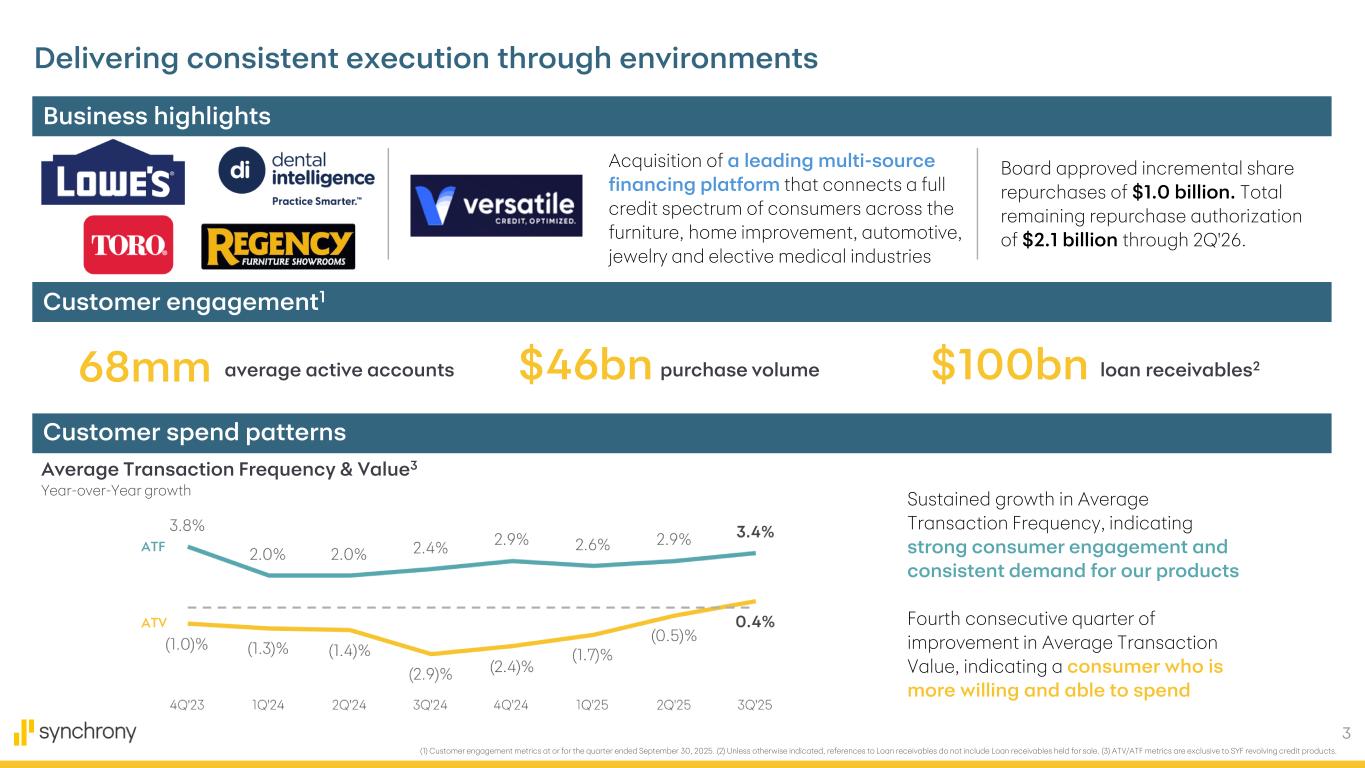
3 (1) Customer engagement metrics at or for the quarter ended September 30, 2025. (2) Unless otherwise indicated, references to Loan receivables do not include Loan receivables held for sale. (3) ATV/ATF metrics are exclusive to SYF revolving credit products. Delivering consistent execution through environments Customer engagement1 Business highlights 68mm average active accounts $46bn purchase volume $100bn loan receivables2 Average Transaction Frequency & Value3 Year-over-Year growth Sustained growth in Average Transaction Frequency, indicating strong consumer engagement and consistent demand for our products Fourth consecutive quarter of improvement in Average Transaction Value, indicating a consumer who is more willing and able to spend Customer spend patterns ATF ATV Acquisition of a leading multi-source financing platform that connects a full credit spectrum of consumers across the furniture, home improvement, automotive, jewelry and elective medical industries Board approved incremental share repurchases of $1.0 billion. Total remaining repurchase authorization of $2.1 billion through 2Q'26.
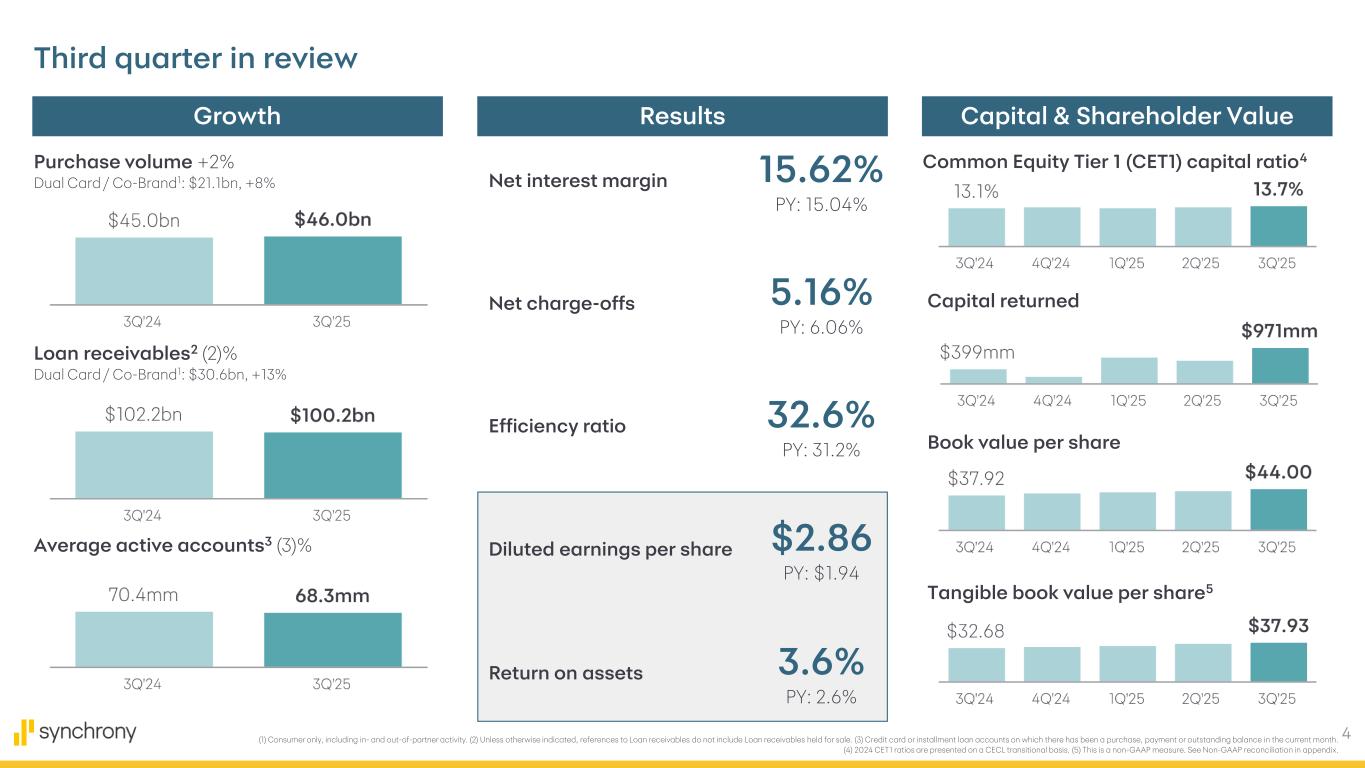
4 Net interest margin 15.62% PY: 15.04% Net charge-offs 5.16% PY: 6.06% Efficiency ratio 32.6% PY: 31.2% Diluted earnings per share $2.86 PY: $1.94 Return on assets 3.6% PY: 2.6% Third quarter in review (1) Consumer only, including in- and out-of-partner activity. (2) Unless otherwise indicated, references to Loan receivables do not include Loan receivables held for sale. (3) Credit card or installment loan accounts on which there has been a purchase, payment or outstanding balance in the current month. (4) 2024 CET1 ratios are presented on a CECL transitional basis. (5) This is a non-GAAP measure. See Non-GAAP reconciliation in appendix. Growth Results Capital & Shareholder Value Loan receivables2 (2)% Dual Card / Co-Brand1: $30.6bn, +13% Book value per share Tangible book value per share5 Average active accounts3 (3)% Common Equity Tier 1 (CET1) capital ratio4 Capital returned Purchase volume +2% Dual Card / Co-Brand1: $21.1bn, +8%
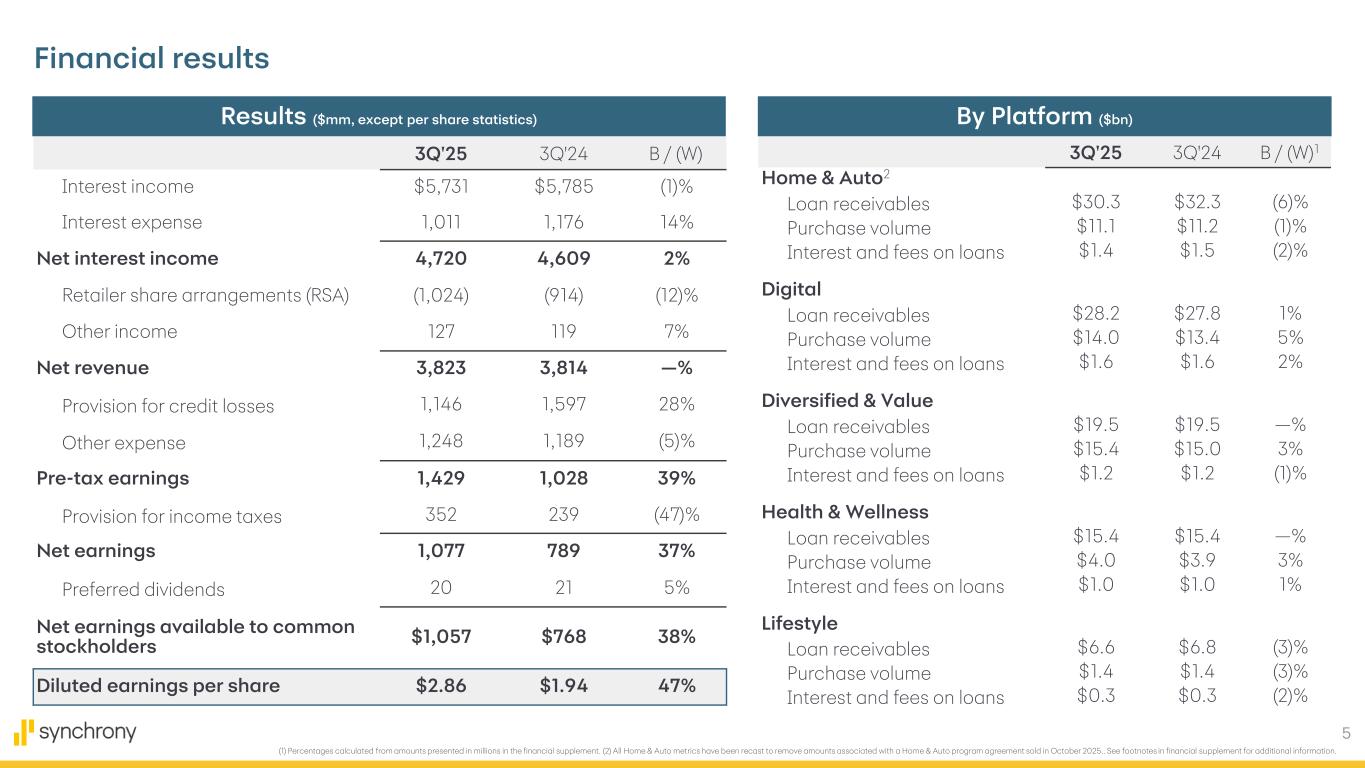
5 (1) Percentages calculated from amounts presented in millions in the financial supplement. (2) All Home & Auto metrics have been recast to remove amounts associated with a Home & Auto program agreement sold in October 2025.. See footnotes in financial supplement for additional information. Financial results Results ($mm, except per share statistics) By Platform ($bn) 3Q'25 3Q'24 B / (W) Interest income $5,731 $5,785 (1)% Interest expense 1,011 1,176 14% Net interest income 4,720 4,609 2% Retailer share arrangements (RSA) (1,024) (914) (12)% Other income 127 119 7% Net revenue 3,823 3,814 —% Provision for credit losses 1,146 1,597 28% Other expense 1,248 1,189 (5)% Pre-tax earnings 1,429 1,028 39% Provision for income taxes 352 239 (47)% Net earnings 1,077 789 37% Preferred dividends 20 21 5% Net earnings available to common stockholders $1,057 $768 38% Diluted earnings per share $2.86 $1.94 47% 3Q'25 3Q'24 B / (W)1 Home & Auto2 Loan receivables $30.3 $32.3 (6)% Purchase volume $11.1 $11.2 (1)% Interest and fees on loans $1.4 $1.5 (2)% Digital Loan receivables $28.2 $27.8 1% Purchase volume $14.0 $13.4 5% Interest and fees on loans $1.6 $1.6 2% Diversified & Value Loan receivables $19.5 $19.5 —% Purchase volume $15.4 $15.0 3% Interest and fees on loans $1.2 $1.2 (1)% Health & Wellness Loan receivables $15.4 $15.4 —% Purchase volume $4.0 $3.9 3% Interest and fees on loans $1.0 $1.0 1% Lifestyle Loan receivables $6.6 $6.8 (3)% Purchase volume $1.4 $1.4 (3)% Interest and fees on loans $0.3 $0.3 (2)%
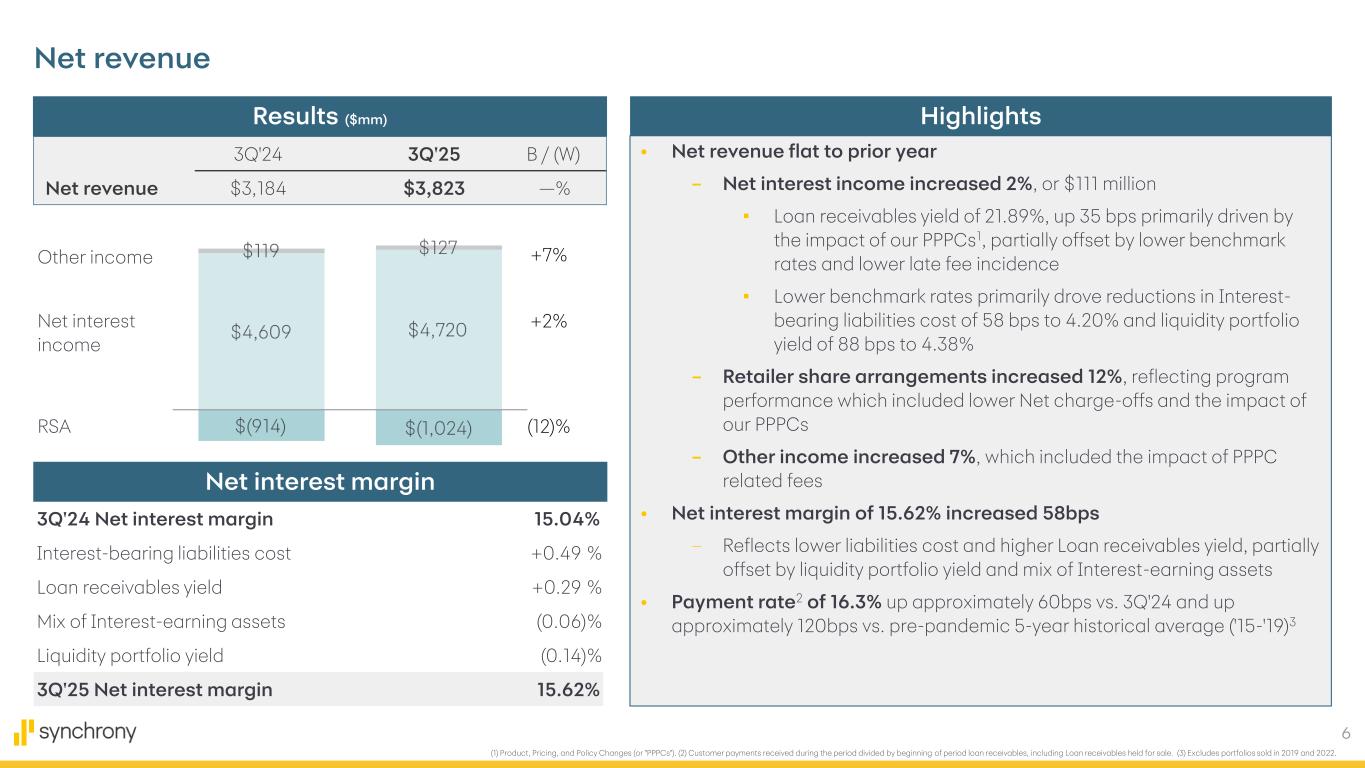
6 (1) Product, Pricing, and Policy Changes (or "PPPCs"). (2) Customer payments received during the period divided by beginning of period loan receivables, including Loan receivables held for sale. (3) Excludes portfolios sold in 2019 and 2022. • Net revenue flat to prior year – Net interest income increased 2%, or $111 million ▪ Loan receivables yield of 21.89%, up 35 bps primarily driven by the impact of our PPPCs1, partially offset by lower benchmark rates and lower late fee incidence ▪ Lower benchmark rates primarily drove reductions in Interest- bearing liabilities cost of 58 bps to 4.20% and liquidity portfolio yield of 88 bps to 4.38% – Retailer share arrangements increased 12%, reflecting program performance which included lower Net charge-offs and the impact of our PPPCs – Other income increased 7%, which included the impact of PPPC related fees • Net interest margin of 15.62% increased 58bps – Reflects lower liabilities cost and higher Loan receivables yield, partially offset by liquidity portfolio yield and mix of Interest-earning assets • Payment rate2 of 16.3% up approximately 60bps vs. 3Q'24 and up approximately 120bps vs. pre-pandemic 5-year historical average ('15-'19)3 Net revenue Highlights Other income Net interest income RSA +7% +2% (12)% 3Q'24 Net interest margin 15.04% Interest-bearing liabilities cost +0.49 % Loan receivables yield +0.29 % Mix of Interest-earning assets (0.06)% Liquidity portfolio yield (0.14)% 3Q'25 Net interest margin 15.62% Net interest margin Results ($mm) 3Q'24 3Q'25 B / (W) Net revenue $3,184 $3,823 —%
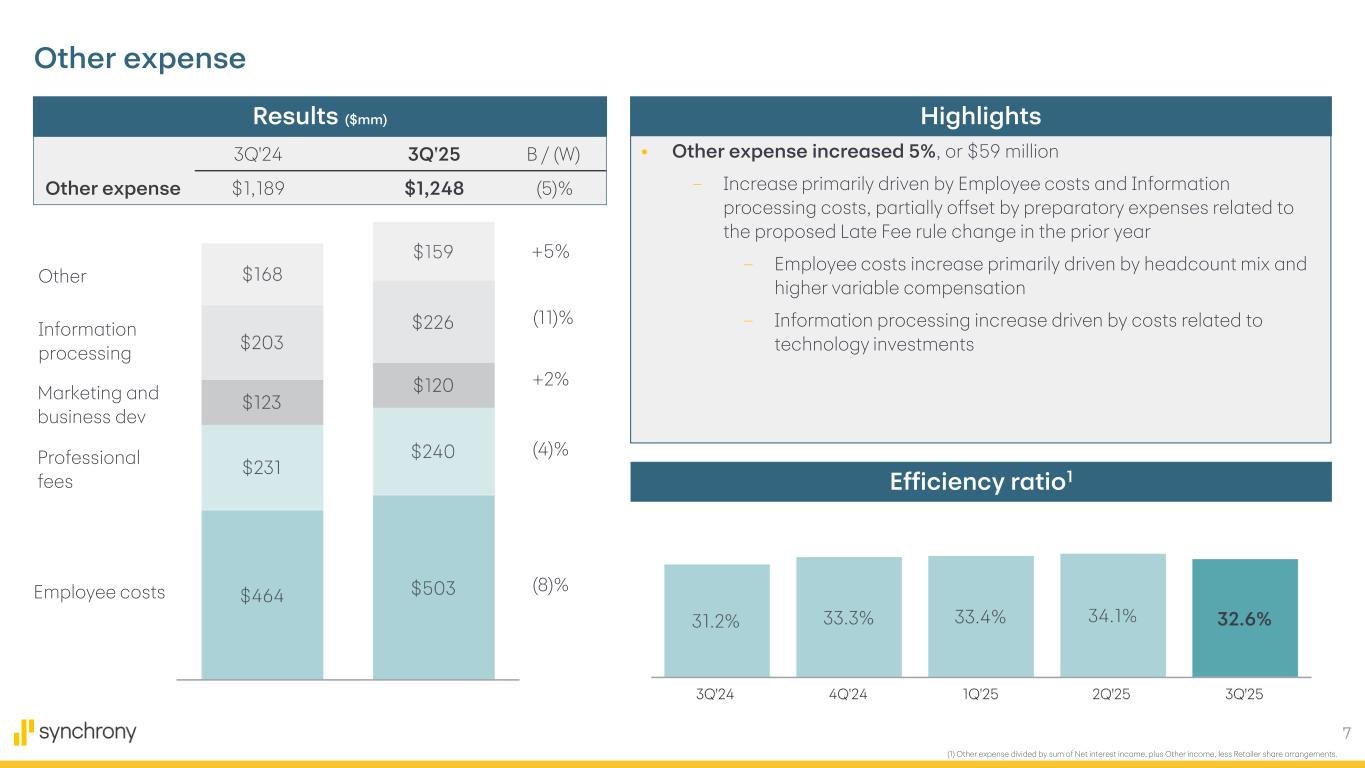
7 (1) Other expense divided by sum of Net interest income, plus Other income, less Retailer share arrangements. 3Q'24 3Q'25 B / (W) Other expense $1,189 $1,248 (5)% Other expense Marketing and business dev Professional fees Results ($mm) Highlights Employee costs +2% (4)% (8)% Information processing (11)% Other +5% Efficiency ratio1 • Other expense increased 5%, or $59 million – Increase primarily driven by Employee costs and Information processing costs, partially offset by preparatory expenses related to the proposed Late Fee rule change in the prior year – Employee costs increase primarily driven by headcount mix and higher variable compensation – Information processing increase driven by costs related to technology investments
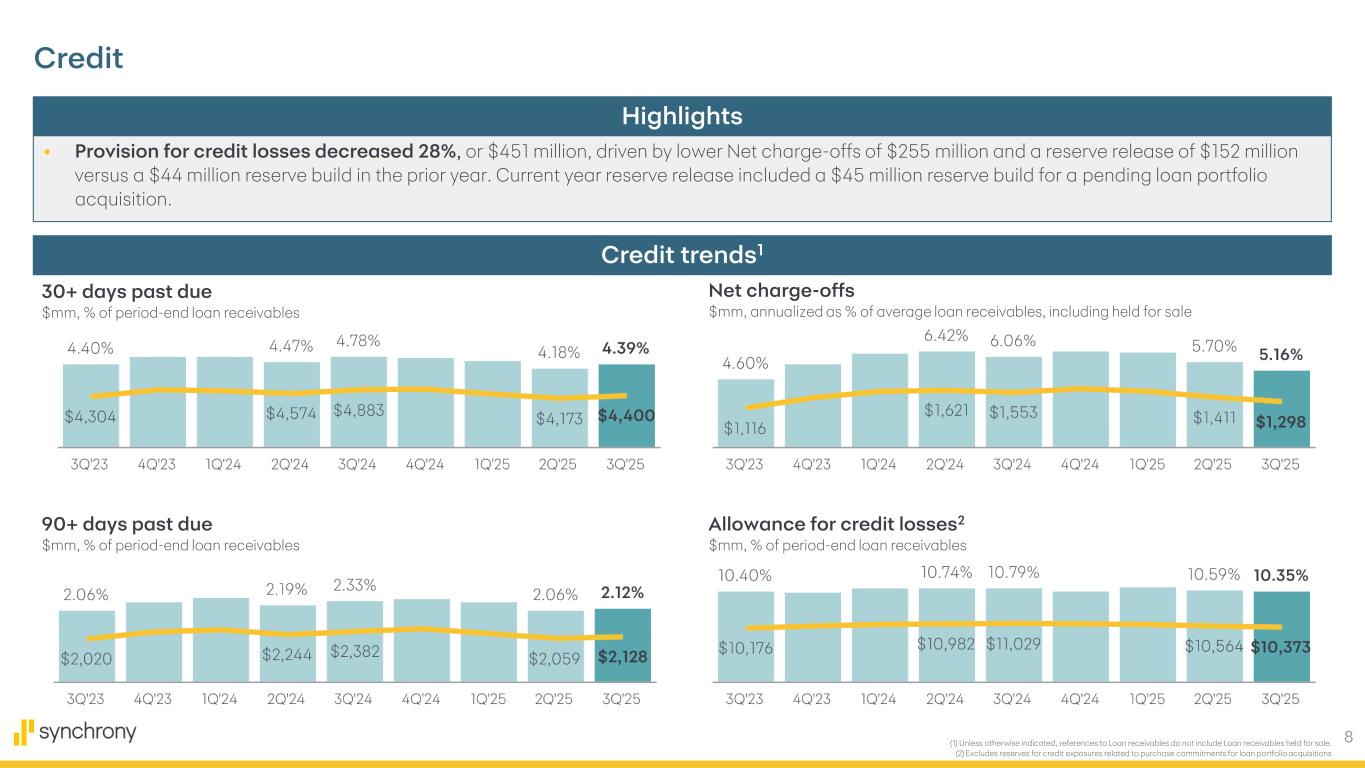
8 • Provision for credit losses decreased 28%, or $451 million, driven by lower Net charge-offs of $255 million and a reserve release of $152 million versus a $44 million reserve build in the prior year. Current year reserve release included a $45 million reserve build for a pending loan portfolio acquisition. (1) Unless otherwise indicated, references to Loan receivables do not include Loan receivables held for sale. (2) Excludes reserves for credit exposures related to purchase commitments for loan portfolio acquisitions Highlights Credit 30+ days past due $mm, % of period-end loan receivables 90+ days past due $mm, % of period-end loan receivables Net charge-offs $mm, annualized as % of average loan receivables, including held for sale Allowance for credit losses2 $mm, % of period-end loan receivables Credit trends1
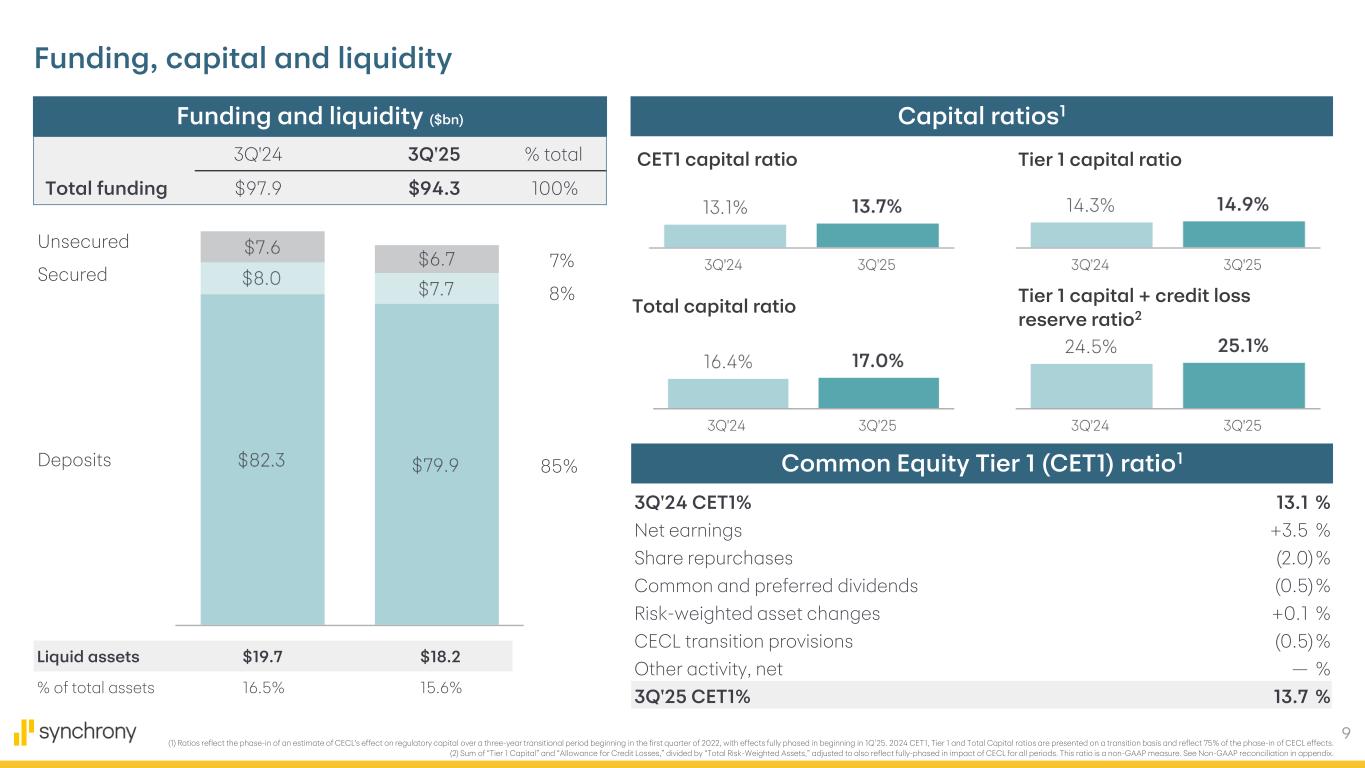
9 3Q'24 CET1% 13.1 % Net earnings +3.5 % Share repurchases (2.0)% Common and preferred dividends (0.5)% Risk-weighted asset changes +0.1 % CECL transition provisions (0.5)% Other activity, net — % 3Q'25 CET1% 13.7 % Funding, capital and liquidity Common Equity Tier 1 (CET1) ratio1 (1) Ratios reflect the phase-in of an estimate of CECL's effect on regulatory capital over a three-year transitional period beginning in the first quarter of 2022, with effects fully phased in beginning in 1Q’25. 2024 CET1, Tier 1 and Total Capital ratios are presented on a transition basis and reflect 75% of the phase-in of CECL effects. (2) Sum of “Tier 1 Capital” and “Allowance for Credit Losses,” divided by “Total Risk-Weighted Assets,” adjusted to also reflect fully-phased in impact of CECL for all periods. This ratio is a non-GAAP measure. See Non-GAAP reconciliation in appendix. Unsecured Secured Deposits 7% 8% 85% Capital ratios1 CET1 capital ratio Tier 1 capital ratio Total capital ratio Tier 1 capital + credit loss reserve ratio2 Liquid assets $19.7 $18.2 % of total assets 16.5% 15.6% Funding and liquidity ($bn) 3Q'24 3Q'25 % total Total funding $97.9 $94.3 100%
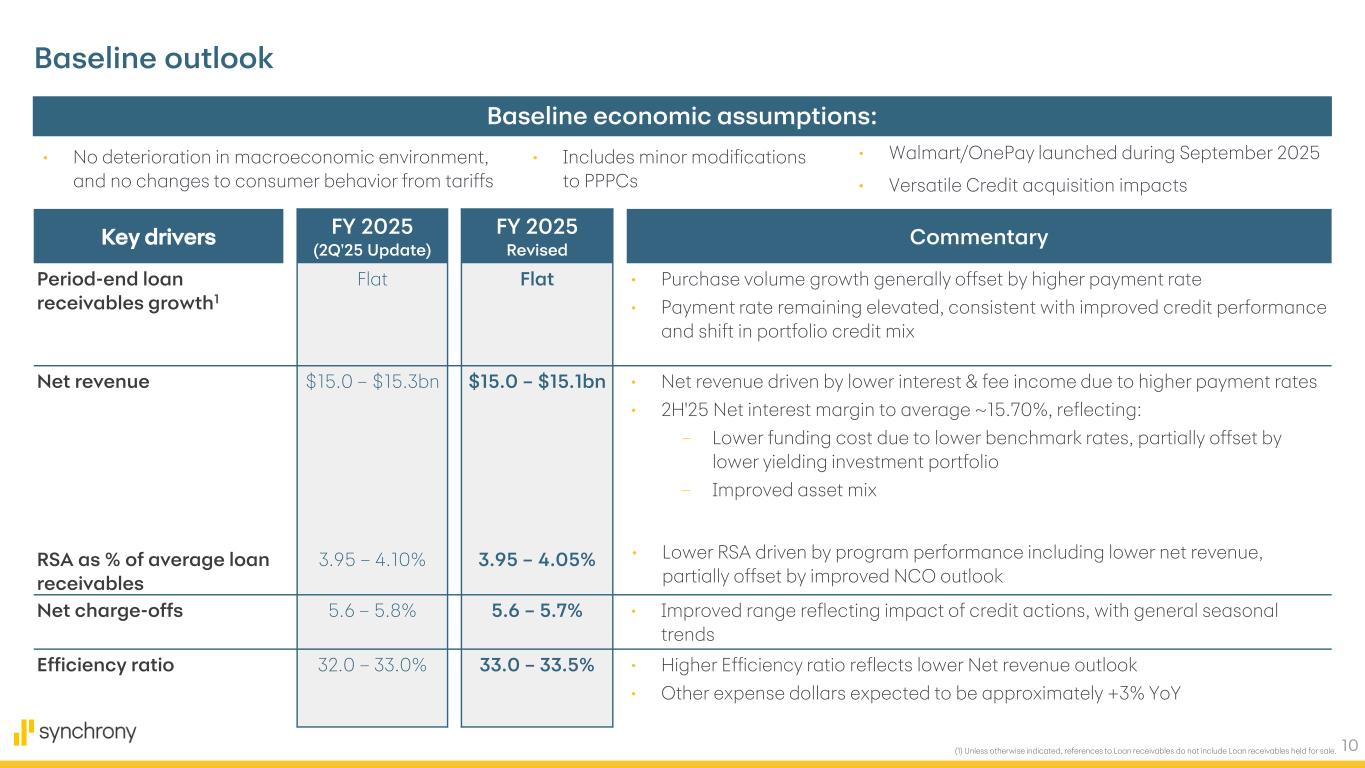
10 Key drivers FY 2025 (2Q'25 Update) FY 2025 Revised Commentary Period-end loan receivables growth1 Flat Flat • Purchase volume growth generally offset by higher payment rate • Payment rate remaining elevated, consistent with improved credit performance and shift in portfolio credit mix Net revenue $15.0 – $15.3bn $15.0 – $15.1bn • Net revenue driven by lower interest & fee income due to higher payment rates • 2H'25 Net interest margin to average ~15.70%, reflecting: – Lower funding cost due to lower benchmark rates, partially offset by lower yielding investment portfolio – Improved asset mix RSA as % of average loan receivables 3.95 – 4.10% 3.95 – 4.05% Net charge-offs 5.6 – 5.8% 5.6 – 5.7% • Improved range reflecting impact of credit actions, with general seasonal trends Efficiency ratio 32.0 – 33.0% 33.0 – 33.5% • Higher Efficiency ratio reflects lower Net revenue outlook • Other expense dollars expected to be approximately +3% YoY • Walmart/OnePay launched during September 2025 • Versatile Credit acquisition impacts Baseline outlook • No deterioration in macroeconomic environment, and no changes to consumer behavior from tariffs • Includes minor modifications to PPPCs (1) Unless otherwise indicated, references to Loan receivables do not include Loan receivables held for sale. • Lower RSA driven by program performance including lower net revenue, partially offset by improved NCO outlook Baseline economic assumptions:

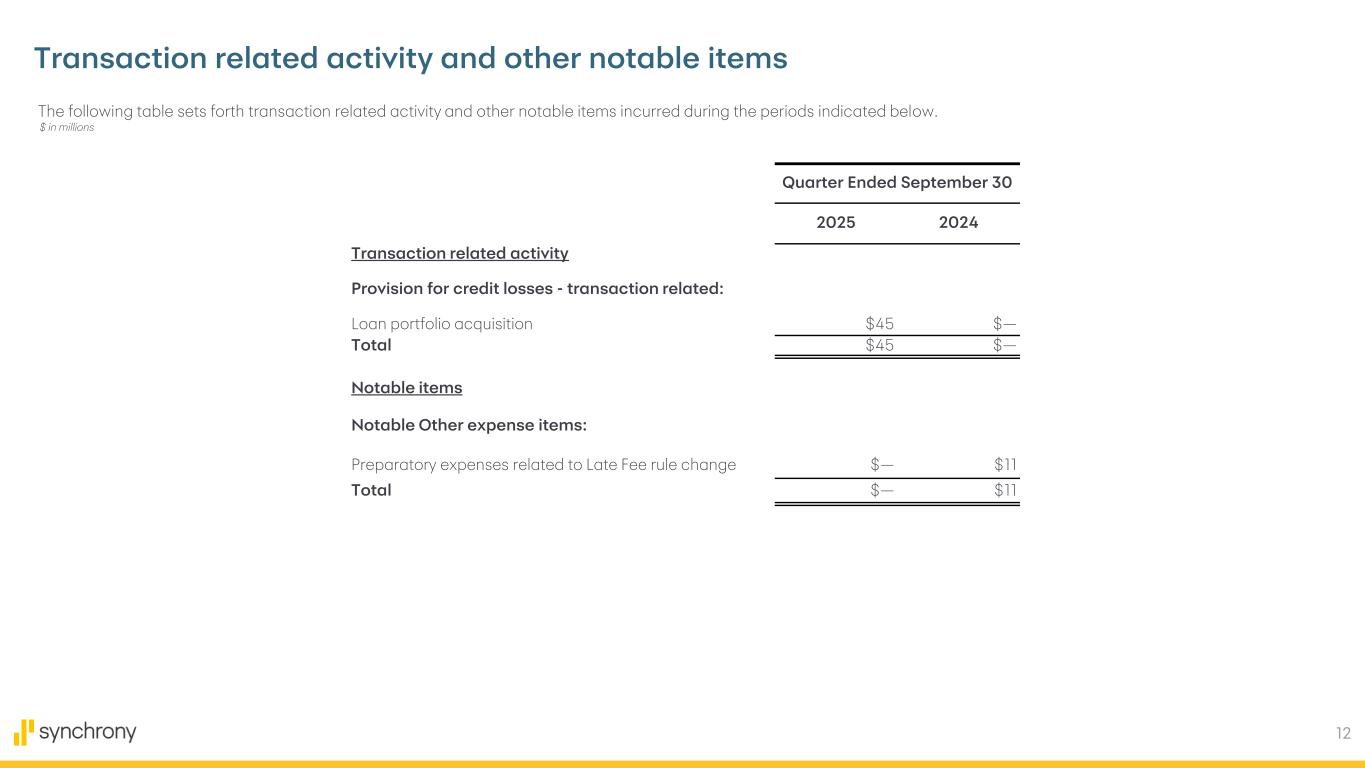
12 The following table sets forth transaction related activity and other notable items incurred during the periods indicated below. Transaction related activity and other notable items $ in millions Quarter Ended September 30 2025 2024 Transaction related activity Provision for credit losses - transaction related: Loan portfolio acquisition $45 $— Total $45 $— Notable items Notable Other expense items: Preparatory expenses related to Late Fee rule change $— $11 Total $— $11
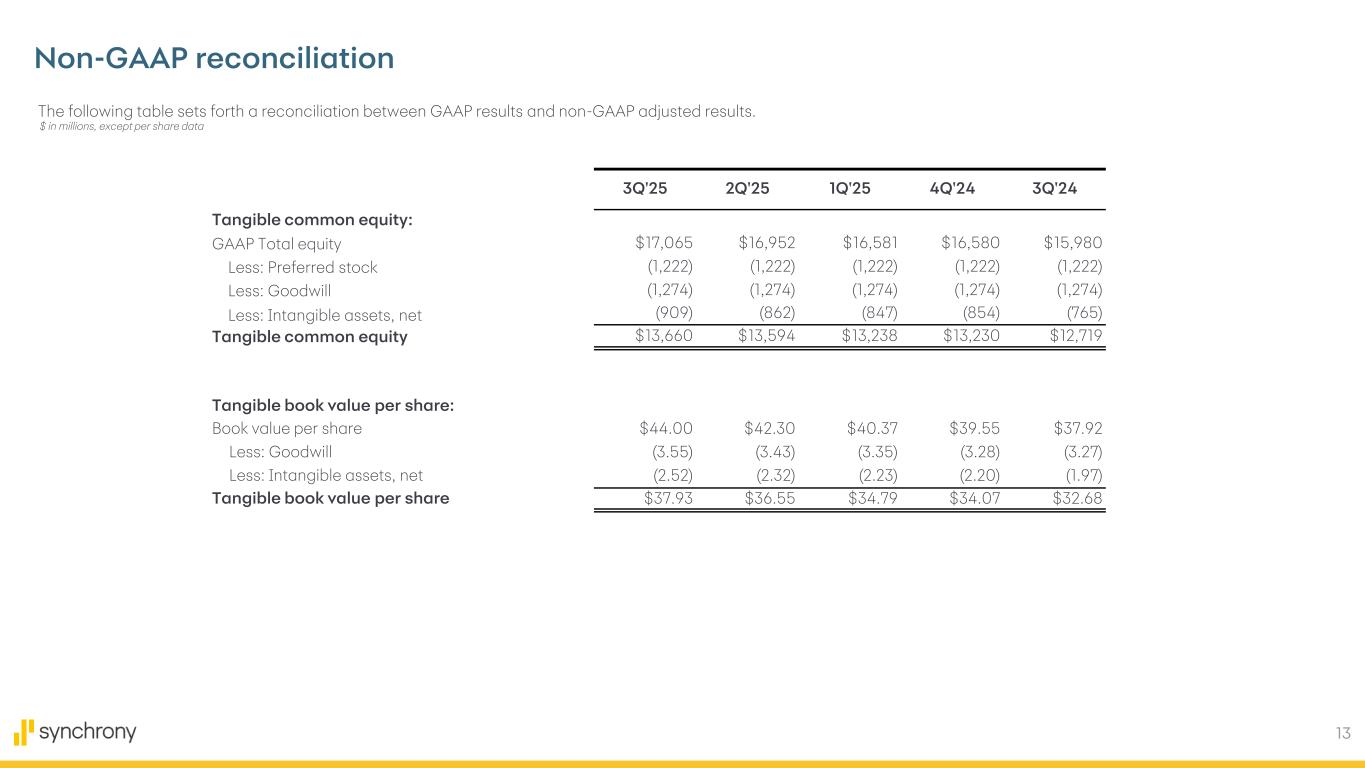
13 The following table sets forth a reconciliation between GAAP results and non-GAAP adjusted results. Non-GAAP reconciliation 3Q'25 2Q'25 1Q'25 4Q'24 3Q'24 Tangible common equity: GAAP Total equity $17,065 $16,952 $16,581 $16,580 $15,980 Less: Preferred stock (1,222) (1,222) (1,222) (1,222) (1,222) Less: Goodwill (1,274) (1,274) (1,274) (1,274) (1,274) Less: Intangible assets, net (909) (862) (847) (854) (765) Tangible common equity $13,660 $13,594 $13,238 $13,230 $12,719 Tangible book value per share: Book value per share $44.00 $42.30 $40.37 $39.55 $37.92 Less: Goodwill (3.55) (3.43) (3.35) (3.28) (3.27) Less: Intangible assets, net (2.52) (2.32) (2.23) (2.20) (1.97) Tangible book value per share $37.93 $36.55 $34.79 $34.07 $32.68 $ in millions, except per share data
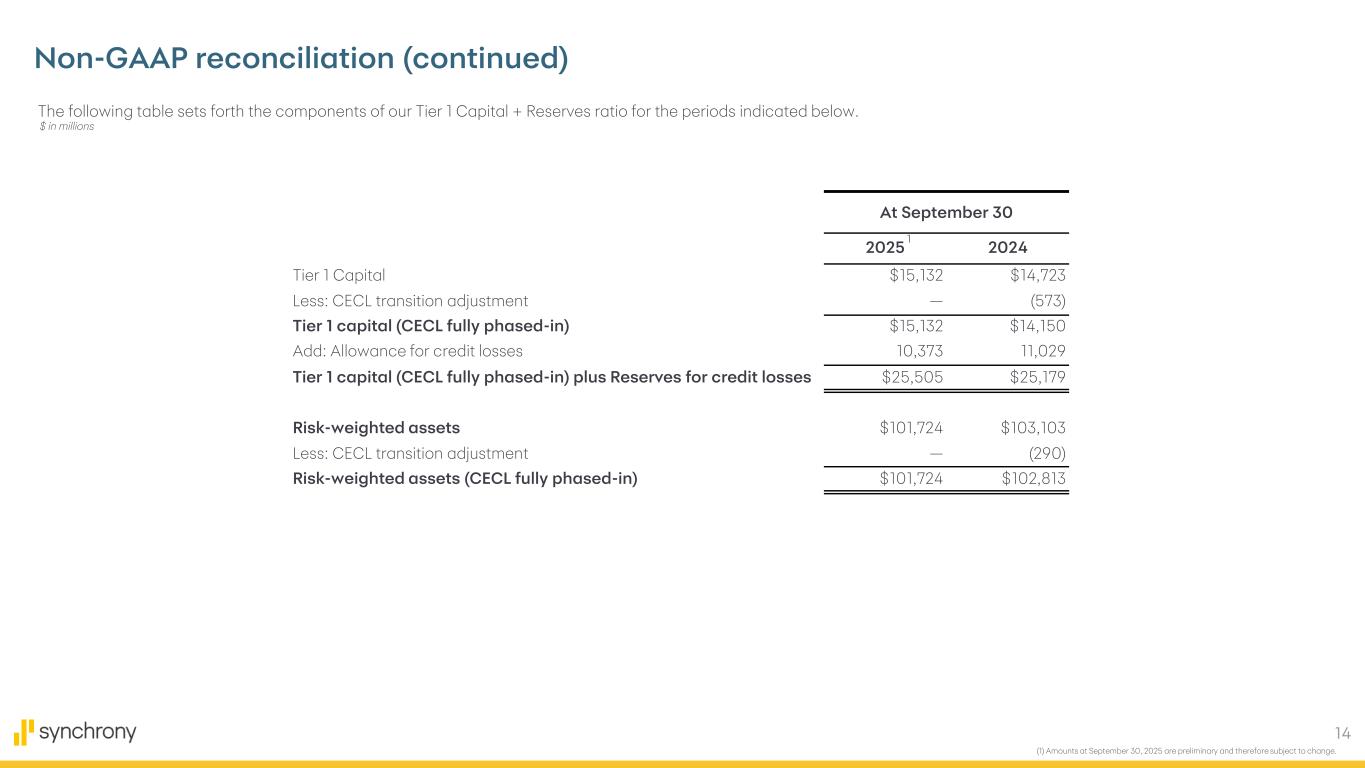
14 $ in millions Non-GAAP reconciliation (continued) At September 30 2025 2024 Tier 1 Capital $15,132 $14,723 Less: CECL transition adjustment — (573) Tier 1 capital (CECL fully phased-in) $15,132 $14,150 Add: Allowance for credit losses 10,373 11,029 Tier 1 capital (CECL fully phased-in) plus Reserves for credit losses $25,505 $25,179 Risk-weighted assets $101,724 $103,103 Less: CECL transition adjustment — (290) Risk-weighted assets (CECL fully phased-in) $101,724 $102,813 The following table sets forth the components of our Tier 1 Capital + Reserves ratio for the periods indicated below. (1) Amounts at September 30, 2025 are preliminary and therefore subject to change. 1